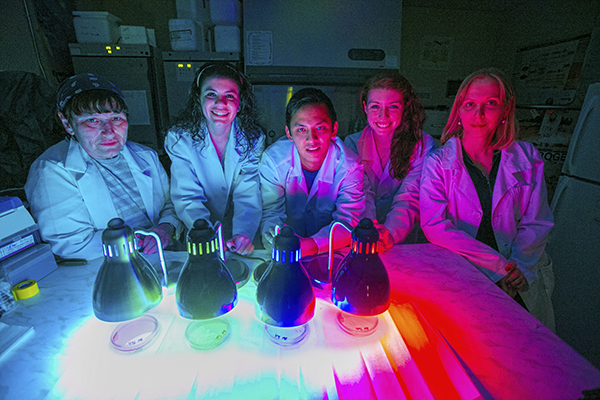There was a time when no one thought about light bulbs—one blew, you screwed another one in. Nowadays, it’s more complicated, as energy efficiency concerns have given rise to a slew of options, including incandescent, compact fluorescent lights, and LEDs.
LEDs are the most expensive option, but they are also the most energy efficient, are getting more cost-efficient, and they are growing in popularity. With this increasing acceptance, concerns have arisen about long- or short-term direct skin exposure—especially since a 2012 SBU study found that contact fluorescent light (CFL) bulbs can harm skin cells due to UV-light emittance (Study Reveals Harmful Effects of CFL Bulbs to Skin).
 |
|
Distinguished Professor of Materials Science & Engineering in the College of Engineering and Applied Sciences Miriam Rafailovich (left), Visiting Assistant Professor Tatsiana Mironava, PhD (right) and undergraduate chemical engineering students Emily Leonard, Jason Caballes, and Stephanie Falco performed tests on the effects of LED lights on skin cells. |
A senior thesis by Stony Brook University Chemical Engineering undergraduates has alleviated the concern. The findings,The Effects of Color LED exposure on Human Dermal Fibroblast Proliferation, Mitochondrial Activity and Cell Morphology, were presented as a poster on March 29 at the American Institute of Chemical Engineers (AIChE) conference.
“LEDs have the potential to be used for both indoor lighting applications and in wound healing therapy, taking the place of lasers,” says Tatsiana Mironava, PhD, a Visiting Assistant Professor in the SBU Material Sciences and Engineering Department, and one of the students’ mentors. “We wanted to assess the effects of color changing light emitting diode bulb exposure on human dermal fibroblast cells.”
The team worked in the lab of Miriam Rafailovich, Distinguished Professor of Materials Science & Engineering in the College of Engineering and Applied Sciences. Dr. Rafailovich, who also directs the Garcia Materials Research Science and Engineering Center at Stony Brook University, was Principal Investigator on the project, and is one of SBU’s most experienced mentors. The students were Jason Caballes, Stephanie Falco, and Emily Leonard.
“The team exposed fibroblast cultures to four LED wavelengths—red, green, blue, and white—for intensity-normalized time periods, so all samples were being exposed to the same power within one test,” Rafailovich says. “The cells were counted using a hemocytometer; the mitochondrial activity was determined through MTS Assay analysis; and cell morphology was analyzed through confocal microscopy images. The cultures were exposed to two different conditions: longer exposure trials with Dulbecco’s Modified Eagle Medium [DMEM], with no phenol red on the samples, and trials without any media, a maximum exposure of 3 minutes.”
The short exposure samples without media displayed a trend of a higher cell proliferation than both controls (one sample stayed in the incubator; one sample was only exposed to ambient light). The long exposure samples that had 1 mL of DMEM media (maximum exposure time of 15 minutes) displayed no trend in growth for the LED exposed cells over the control samples.
“At this point, we have seen the consistent trend that LED exposure is not harmful to human dermal fibroblasts,” Leonard reports. That helps clarify the scientific thinking on the subject, according to Falco. “When we first started preliminary research for our paper, we ran into several conflicting opinions of whether or not LED lights were harmful,” she says. “Some people claimed that they did damage to skin cells, while others were using them to heal wounds, so it was gratifying to see for ourselves that cells were proliferating under the LEDs.”
Dr. Mironava confirms the students’ conclusions. “LEDs definitely don’t hurt dermal fibroblasts cells, and pose no risk at all,” she says. “In fact, in some cases we observed an increase in mitochondrial activity and cell proliferation, which indicates that exposure to LED light may be beneficial for the cells.”
The students are now investigating the influence of LED light exposure on factors affecting wound healing.












